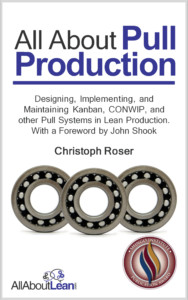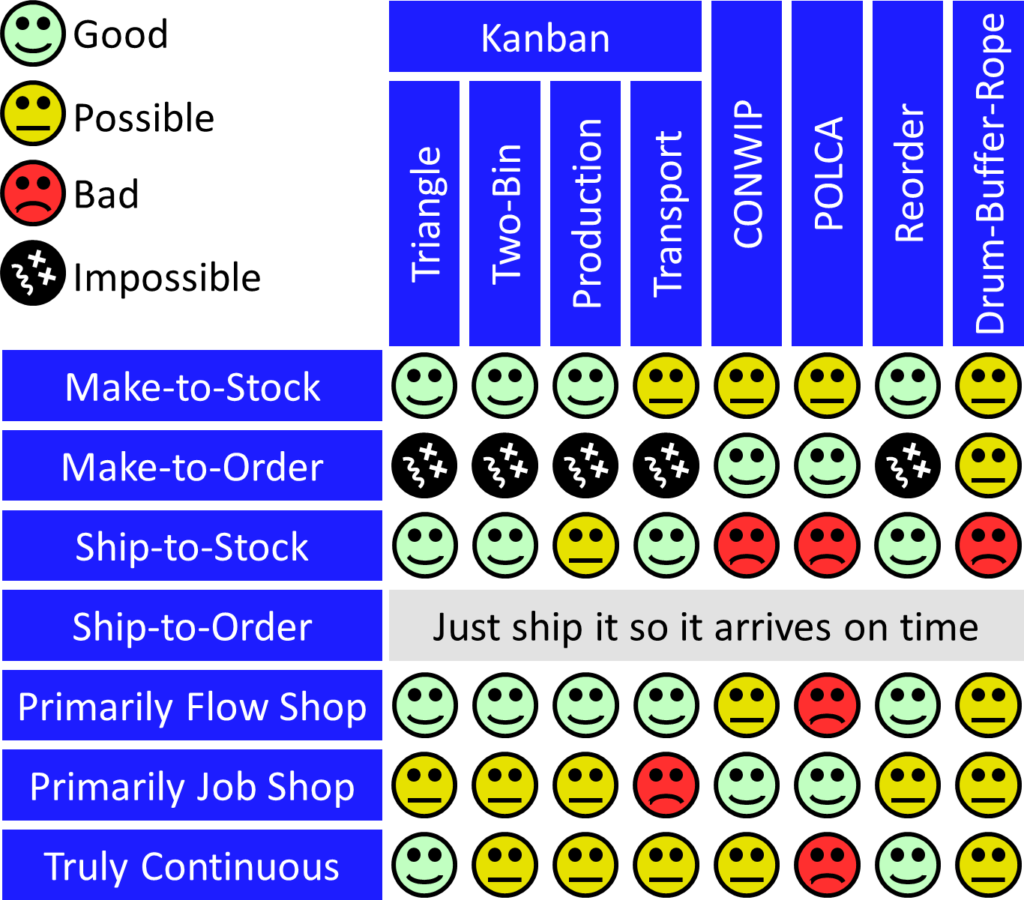 In my last few posts I showed you different types of pull systems, and an overview of the criteria on how to decide which one is right or you. In this post I finally give you a hands-on guide to decide which pull system to use. This blog post is loosely based on chapter 3.2 of my new book All About Pull Production: Designing, Implementing, and Maintaining Kanban, CONWIP, and other Pull Systems in Lean Production. Let’s have a look:
In my last few posts I showed you different types of pull systems, and an overview of the criteria on how to decide which one is right or you. In this post I finally give you a hands-on guide to decide which pull system to use. This blog post is loosely based on chapter 3.2 of my new book All About Pull Production: Designing, Implementing, and Maintaining Kanban, CONWIP, and other Pull Systems in Lean Production. Let’s have a look:
This is a cross post with the same article on Planet Lean.
Introduction
 Two posts ago, I listed a number of different types of pull system. These are again listed below. This series of post is based on my new book, and you can find much more details on all these pull systems and how to use them in there.
Two posts ago, I listed a number of different types of pull system. These are again listed below. This series of post is based on my new book, and you can find much more details on all these pull systems and how to use them in there.
- Kanban (for make-to-stock only, with variants of production kanban, transport kanban, two-bin kanban, and triangle kanban)
- CONWIP (similar to kanban but for make-to-order)
- POLCA (make-to-order for job shops)
- Reorder point and reorder period (mostly for purchasing)
- Drum-Buffer-Rope (if you are a hardcore fan of the Theory of Constraints)
- COBACABANA (complicated, and no real-world implementation so far)
Suitability of Pull Systems
Let me first give you an (admittedly very subjective) evaluation of the different pull systems, and how well they fare with different requirements. In the image below, I summarize which type of pull system is compatible with make-to-stock, make-to-order, ship-to-stock, ship-to-order, and flow shops or job shops, as well as truly continuous processing of bulk materials. Please note that any kanban system and reorder systems are fundamentally incompatible with make-to-order. Also note that if you are shipping items based on a customer order, you do not really need a pull system; you merely need to ship the items so they arrive on time.
Pull System Selection Decision Tree for Manufacturing
 To help you in your decision of which pull system to use, I have created decision trees to help you select a suitable pull system for you. Please be aware that these recommendations include a lot of assumptions and generalizations. Yet overall, these recommended systems are all feasible options. Because of the length of these options, I have split them into a decision tree for production or development in this section and a decision tree for purchasing in the next section.
To help you in your decision of which pull system to use, I have created decision trees to help you select a suitable pull system for you. Please be aware that these recommendations include a lot of assumptions and generalizations. Yet overall, these recommended systems are all feasible options. Because of the length of these options, I have split them into a decision tree for production or development in this section and a decision tree for purchasing in the next section.
The first decision tree below looks at production or development. If you produce make-to-stock, your best choice is usually a variant of kanban. If you produce make-to-order, you have the choice between CONWIP and POLCA. POLCA is a bit better in controlling the inventory, but is more cumbersome to implement and maintain. POLCA is also not designed for flow lines, but for job shops and networks of cells. CONWIP is easier to implement and maintain, but doesn’t control the inventory in a job shop as nicely.
If you have a mixed system, you will need to choose two separate systems for the make-to-stock and the make-to-order items. Here, I recommend a combination of kanban and CONWIP.
Most systems are well suited for discrete production, where a card represents a fixed quantity. Even with continuous production, either the production or the sale is often in fixed quantities. However, with a truly continuous production, you cannot use cards for a fixed quantity of items. Here, it may be best to use reorder points for make-to-stock or CONWIP for make-to-order. However, many other systems can be adapted to continuous production with varying effort.
If you are producing make-to-stock, you have a few more decisions. First, if you are in the unfortunate situation to produce make-to-stock in a job shop, see if you can turn the job shop into a flow shop. If not, select a flow shop type pull system, although you additionally may have to take care of the routing of the items within the job shop.
If you produce make-to-stock in a flow shop, you can now fine-tune the system. If the demand is low and the demand during the replenishment time is consistently less than the content of a single container, then you may need only a two-bin system. This is a kanban system with only two cards.
If the demand is higher, you may look at the value and size of the items. If they are a bit expensive or bulky, use a normal kanban system with production and transport kanban to minimize inventory and hence minimize tied-up capital and/or storage space.
If the items are very small and very cheap, you may use a triangle kanban to reduce the number of times you have to produce, although you still may choose a normal kanban to create smaller lot sizes and improve leveling.
Pull System Selection Decision Tree for Purchasing
The decision tree is easier for purchasing. If you ship-to-order, you do not need a pull system at all. You just order all the items you need so they arrive on time when you need them. If the items are needed for your own production, the pull system of the production will decide when to produce what, and your ship-to-order items are derived from this make-to-order production system. Since you cannot produce before the parts arrive, the delivery times are part of the overall lead time for the customer order.
If you order items to be on stock (ship-to-stock), the decision tree is similar to the make-to-order flow shops. If demand is very low, make sure you always have at least two items or batches. If one is consumed, order one more while the second item or batch ensures material availability.
If the demand is higher, you may use triangle kanban for very cheap and very small items, and transport kanban for larger or more expensive items. This is similar to the make-to-stock production. For all ship-to-stock methods, reorder systems are a valid alternative, as you can adjust the reorder points and reorder quantities to achieve a wide range of behaviors similar to the different kanban systems.
What About Drum-Buffer-Rope and COBACABANA?
 You may wonder which decisions you have to make to get to Drum-Buffer-Rope, as none of the above decisions end up there. Drum-Buffer-Rope is in my view mostly inferior to kanban and CONWIP systems. Drum-Buffer-Rope requires the pull loop to end before the bottleneck, which in my view is a completely unnecessary restriction. If you ignore the restriction of the loop ending at the bottleneck, the system is actually very similar to CONWIP and quite workable.
You may wonder which decisions you have to make to get to Drum-Buffer-Rope, as none of the above decisions end up there. Drum-Buffer-Rope is in my view mostly inferior to kanban and CONWIP systems. Drum-Buffer-Rope requires the pull loop to end before the bottleneck, which in my view is a completely unnecessary restriction. If you ignore the restriction of the loop ending at the bottleneck, the system is actually very similar to CONWIP and quite workable.
There are real-world production systems that successfully use Drum-Buffer-Rope. Hence, if your plant successfully uses Drum-Buffer-Rope, has people skilled in it, and the method has the support of your people, by all means keep using it. I am fine with anything that works. Just don’t artificially constrict yourself to end the loops at the bottleneck. If you have not yet done Drum-Buffer-Rope, however, I recommend that you stick to kanban and CONWIP systems. I also advise against COBACABANA, as it is complicated and untested in reality. Now, go out, set up a good pull system for your products, and organize your industry!
Series Overview
- Pull: A Way Forward for Supply Chains – Guest Post by John Shook
- The Different Ways to Establish Pull Production
- What Are the Criteria to Decide on a Pull System?
- Which Pull System Is Right for You?
- What Different Pull Systems Can Be Combined?
Source
This blog post is summarized from my latest book on pull production, where you will find many more details on all of these systems and how they can work together. You will also find a foreword by John Shook.
Roser, Christoph. All About Pull Production: Designing, Implementing, and Maintaining Kanban, CONWIP, and other Pull Systems in Lean Production. 441 pages: AllAboutLean.com Publishing 2021.




Absolutely one step forward for “Pull” operation. The practitioner can get the practical idea 1) by studying these posts, and 2) by studying their own situation and the purpose (e.g., the client requests “Pull”, the business needs “Pull”), I think.
Of course, other points also to be studied, e.g., 1) Having semi-finished goods or finished goods, 2) How bout your suppliers?
Hello Osamu, always good input from you. The pull system is of course not only for the final product, but ideally the entire value chain would be a sequence of pull loops, also providing materials and (if possible) also include the suppliers.
Reorder point as a pull-system for purchasing makes sense. In fact, I don’t see why you would use any other system as your supplier is in charge of the challenge of scheduling the orders and all other challenges of production and delivery. But how would reorder point work as a fully fledged pull-system for production? It tells you how much you need to make (the signal) but beyond that it isn’t much of a system for production at all. Which is why I agree with your decision tree and only recommend it for continuous production. But then why does it get so many green smileys in your suitability table? For make to stock and flow shop, shouldn’t it have neutral smileys to differentiate from KANBAN?
Hi Ronnet, reorder points can clump orders together. This would be the opposite of leveling, and could cause problems for the supplier (although it also depends on the details of your reorder system parameters). That’s why Toyota does use kanban also for suppliers.
As for manufacturing, reorder points can be used if you explicitly want a larger lot size (e.g. due to longer change overs). But I also agree, maybe I should make the reorder system for make to stock, flow shop, and job shop a neutral smiley. Good point.